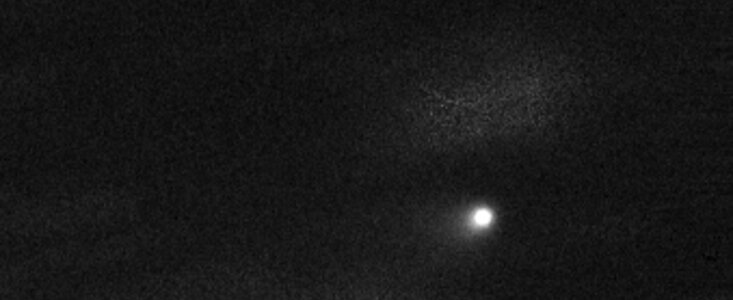Gemini Images Comet Hours Before Probe’s Landing
17 November 2014
New Gemini Observatory images show an Earth-based perspective of the comet targeted by the Rosetta spacecraft. The images capture the comet about nine hours before the Philae probe landed on the “dirty snowball’s” surface.
A series of images released today by the Gemini Observatory reveal Comet 67P/Churyumov-Gerasimenko (67P, the comet currently being explored by the European Space Agency’s Rosetta spacecraft) as it glides against a starry background. The images were obtained over a 26-minute period -- and only nine hours prior to the successful landing of the washing-machine sized probe, called Philae, which bounced to a safe landing on the comet’s surface.
Images, like these from Gemini, and other telescopes, allow the Rosetta team to monitor the total activity level of the comet. In addition, they provide scientists with the data needed to study how the large-scale coma (the comet’s atmosphere) and its tails develop. Meanwhile, Rosetta's instruments concentrate on the nucleus and innermost tens-of-kilometers of the coma. "Through this scientists can simultaneously investigate the whole comet at all distance scales," says team member Colin Snodgrass.
The images, obtained with the Gemini Multi-Object Spectrograph on the Gemini South telescope in Chile, reveals the extent of the comet's coma, which extends at least 12,000 kilometers in diameter. Rosetta and the comet's nucleus, with Philae on it, are all hidden within the central pixel in images seen from Earth - each pixel spans an area 400 kilometers wide at the Earth-comet distance. The nucleus itself occupies only 1/10,000th of a pixel, and the spacecraft are much smaller, highlighting just how difficult the landing of Philae was (as directed from Earth).
Team lead Matthew Knight points out that these observations from the ground are also challenging. "Since the comet is very low on the horizon and sets very soon after sunset, as well as being set against myriad Milky Way stars, this makes it a challenging task for even the best of the world’s telescopes."
67P is currently 3.4 Astronomical Units (AU) from Earth (approximately 500 million kilometers) and 3 AU from the Sun, between the orbits of Mars and Jupiter, at the same distance as the outer edge of the asteroid belt. Rosetta is currently orbiting the comet at a distance between 30 and 50 kilometers from the surface of the nucleus, which is estimated to be about four kilometers wide.
The team responsible for the Gemini images of Comet 67P is led by Matthew Knight (Lowell Observatory), and includes Colin Snodgrass (Open University, UK), and Blair Conn (Gemini Observatory). Observational data were obtained by Pascale Hibon and Andrew Cardwell.



